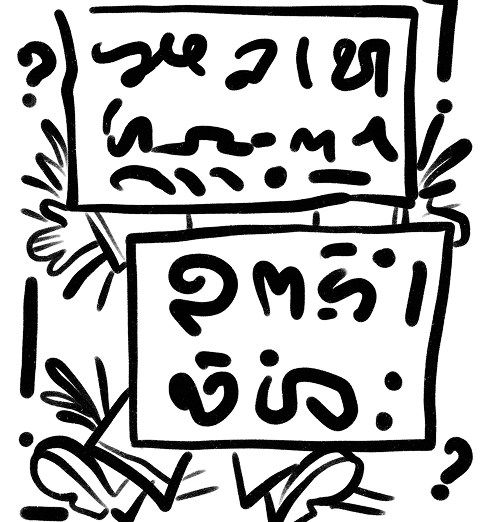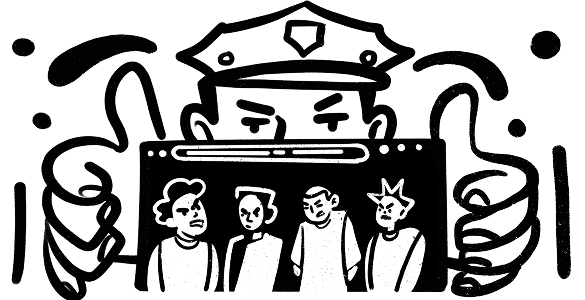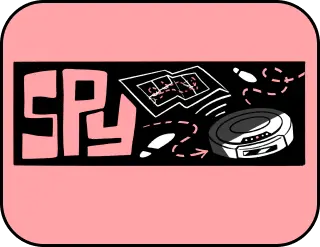Codes of the underworld: from tattoos to digital encryption
Disclaimer. The editorial board of The Global Technology magazine strongly emphasizes that this article is intended for informational purposes only.
The science of encryption has given humanity safe ways to communicate and has protected people from countless potential threats. At the same time, encryption has been used by various criminal elements to securely conceal their intentions. In this article, we aim to shed light on some encryption methods used by criminal groups, in order to protect society from such shameful repetitions in the future.
The law of the dark world says: “If you want to survive — disappear into the shadows. Leave no trace, speak no words that could become evidence.” In the criminal underworld, a mistake equals the price of freedom. And making mistakes is human nature — both for those in the law-abiding world and those in the criminal world.
That is why, to hide secret messages, some draw signs on brick walls, others hide meaning in familiar phrases, and some encode commands into random numbers.
Killers, mafia members, smugglers, thieves — all believe they can hide the truth behind codes and symbols. But every mystery eventually finds its detective.
Messages Without a Trace: The Criminals’ Main Weapon Against Justice
“A fish is killed by an open mouth.”
In the criminal world, any word can become incriminating, any note — a death sentence. Experienced criminals know that information must be buried deep, wrapped in numbers, disguised as symbols, and only then it stops being evidence. Information becomes a labyrinth, a key to which is held only by insiders.
In the criminal world, codes, symbols, and secret signs become a weapon.
Criminals often resort to encryption because:
1. They need to operate under surveillance
Every word can be overheard, every letter intercepted. Phones are tapped, letters are opened, cameras record the tiniest gestures. In today’s world, where cameras capture every move, an ordinary conversation becomes a trap.

But ciphers turn information into an impenetrable wall. Even if a message falls into the wrong hands, without a key, it remains a useless set of symbols. Wiretaps turn into meaningless noise, letters into chaotic strings. Special services may watch criminals, but understanding their words is a completely different battle.
2. They need to hide information from enemies and allies

The criminal world is full of enemies. Anyone who knows too much becomes a target. Partners may betray, competitors may steal information, allies may sell it for their own survival.
Encryption becomes a barrier that protects secrets even when everything goes wrong. If a message is intercepted, it will be useless without the key. If someone tries to uncover the plot, they will only have mysterious numbers and meaningless words in their hands.
Whoever holds the code — holds the power. Whoever doesn’t — gets lost in the unknown.
3. They need to complicate the work of law enforcement agencies
In the criminal world, every second counts. While the police are trying to break the cipher, criminals get a chance to escape, destroy evidence, or change plans. Some encrypted messages are so complex that deciphering them can take months — sometimes even years.
In 1999, the body of courier Ricky McCormick, who was carrying illegal substances, was found in a cornfield in Missouri. Alongside him were two encrypted notes. The FBI was convinced that these notes contained a code that could help the police solve the case, but despite the efforts of the best codebreakers, the encrypted message has never been deciphered.
McCormick’s associates disappeared, and the investigation hit a dead end. To this day, the contents of the notes remain a mystery, and the man’s murder is still unsolved.
It is quite possible that the cipher itself was not used for protection but for disinformation. Complex codes can mislead investigators, create false trails, and distract from real evidence, forcing law enforcement to waste time on non-existent puzzles.
How Law Enforcement Break These Ciphers
Every encrypted message is a multi-layered puzzle that hides intentions and important information about criminal activities. But experienced investigators know: every secret has its vulnerability, and no one can guarantee absolute protection.
When decoding criminal messages, as in a true detective novel, law enforcement agencies engage in a silent, relentless battle, slowly moving closer to unraveling the mysteries that criminals believe are unsolvable.
Skilled codebreakers understand that in the world of ciphers, every wrong move, every minor oversight can be decisive.

The Linguistic Trail: Everyone Has Their Own Signature
Linguistic analysis in investigations is like searching for fingerprints at a crime scene, but instead of prints, the traces are words and phrases. When a criminal leaves an encrypted message, they unintentionally use elements of their own speech patterns — word choices, grammatical constructions, or favorite expressions. This is what allows experienced investigators to identify the “handwriting” of the criminal.
By analyzing notes or correspondence, special attention is paid to repeating words and unusual phrases. The criminal might use expressions typical of their background or upbringing. They might use strange wording that reveals their emotional state at the moment of committing the crime.
The tone of the message, excessive details, strange emphases, and artificially restrained expressions — all these can tell about the criminal’s intentions and psychological background.
Mistakes and omissions may seem random, but an experienced investigator knows they might reveal not only gaps in education but also clues to the cipher itself.
By uncovering the structure of the text, an investigator can decrypt the message and understand the profile of the criminal — their personality, mindset, and even future plans.

There was a case in criminal history where law enforcement discovered correspondence between an inmate and his wife.
In this exchange, they noticed a repeating phrase: “Don’t worry.” After thorough analysis, investigators identified an interesting pattern: this phrase acted as a divider between key instructions — every time it was followed by a short but important phrase indicating the next step.
By piecing together all parts of the correspondence, investigators decrypted the message, which turned out to be a secret communication for accomplices: “Don’t worry, everything is going according to plan. It’s time to start the operation.” This discovery allowed authorities to intervene in time and prevent criminal actions.
Setting Traps
Even if a criminal carefully hides their messages and uses the most sophisticated encryption systems, they can still fall into a trap. These traps can take the form of special programs created specifically to encrypt criminal messages.
In 2020, a group of criminals actively used Anom, a messenger service that utilized a dynamic encryption system and was therefore considered an unbreakable fortress. But what the criminals didn’t realize was that the creators of this messenger were not hackers, but law enforcement agencies themselves.

Over two years, special services intercepted tens of thousands of messages, in which drug deals, arms trafficking, and even murder plots were discussed. Criminals, confident in their impunity, had no idea that their secret world had long become transparent.
The Criminal and the Agent
But there is an even more dangerous game that law enforcement agencies play when they decide to place an undercover agent inside a criminal organization. Such infiltration is long and risky — every word, every glance can be fatal. Yet this method often allows the authorities to crack the most complex codes. An agent who becomes part of the system can gain access to secret communication methods and decode what criminals are trying to hide.
However, no matter how carefully criminals try to protect themselves, there is always one element beyond their control — the human factor. Even the most secure systems can be compromised if someone inside the criminal group is not careful enough. And these mistakes often become turning points in investigations.
Detective Archives: Secret Codes of the Criminal World
Case No. 001 — Italian Mafia: The Pizzini Cipher
The Italian Mafia has always used a complex communication system, developing its own language of ciphers to deliver orders while remaining hidden. One such method was the the Pizzini Cipher — tiny notes with coded instructions.
In 2006, Italian law enforcement managed to intercept several of these notes, which led to the arrest of Bernardo Provenzano, the head of the Sicilian Mafia, who had been in hiding for over 40 years. His typewritten notes contained sequences of numbers and fragments from the Bible and other texts.
The system was simple:
The mafia boss wanted to issue an order to eliminate a traitor but feared interception. So, he wrote a neutral letter on a typewriter, embedding strange numbers:
“Lorenzo, my boy, this is your uncle Giovanni. How are you? Do you remember how we went with the whole family to Sicily to celebrate grandma’s birthday, who sadly is no longer with us? Pray for her. Take the prayer she used to read before every meal.
7-3-14, 23-6-15, 45-2-9, 61-7-1, 32-4-32.”
These simple numbers had specific meanings. The recipient was instructed to open a Bible and find the corresponding chapters and verses. For example, 7-3-14 meant: page 7, paragraph 3, the 14th word.
If deciphered correctly, the full message would read:
“Antonio is a rat, betrayed us, eliminate him.”
Thus, using Pizzini, mafia groups could exchange orders and remain safe.
But eventually, the system was cracked. The Pizzini Cipher was revealed through careful analysis of intercepted messages, where codebreakers noticed patterns in the number combinations. Experts realized that the numbers pointed to Bible verses, and letters taken from these verses formed hidden messages. This method of decryption allowed authorities to uncover critical mafia instructions, including orders and plans, ultimately leading to the capture of Bernardo Provenzano and the collapse of his criminal network.

Case No. 233 — Thieves: Symbols on Doors
Thieves and burglars worldwide have used a system of small symbols left on doors and walls to communicate with their accomplices. These tiny symbols looked like random drawings but carried secret meanings understood by criminals. Such marks were often placed in visible spots, so other members of the criminal group could quickly identify information about the house and its owners.
For instance, a slanted line drawn on a door might signal that the house was well-guarded, making a break-in risky. Simple crosses or circles could indicate that valuables are inside, and the house is an easy target because the owners skimp on security. Symbols varied depending on the region or criminal group, but the purpose was always the same: to convey information without words, allowing criminals to act in coordination.

Case No. 310 — Yakuza: Secret Tattoos
The Yakuza, a Japanese criminal organization, has used tattoos for many years as complex codes for hidden information transmission. Every image, every pattern in such tattoos can reveal crucial details about criminal operations.
For example, the dragon symbol, which often appears on the bodies of Yakuza members, indicates affiliation with a particular family, while hidden details within the image reveal the owner’s position in the hierarchy.
Hidden numbers or symbols embedded in the image of a dragon can contain dates, geographical coordinates, or coded names, encrypted using, for example, the Caesar cipher. Such symbols become the key to uncovering criminal connections when understood correctly.
Decoding these messages requires great experience and a deep knowledge of Yakuza culture, its structure, and peculiarities. Criminalists who have extensively studied the world of tattoos can, thanks to the images on the bodies of gang members, track the movements of organization members, uncover hidden links, and predict their next actions.

Case No. 666 — Mafia in America: Coded Conversations
In the 1920s, American gangsters used special phrases in their communication to hide information from the police and competitors. They embedded coded phrases or words in their dialogues that contained vital details about meeting locations, arms supplies, and operations. For example, the phrase “I am tuning my violin” meant preparing for an attack, while the phrase “It’s time to take a walk around the city” signaled that contraband transportation was planned.
Special agents embedded within criminal groups noticed that certain phrases spoken by mobsters made no sense in the context of an ordinary conversation. They shared their suspicions with criminologists, and after some time, experienced specialists were able to identify patterns: meaningless phrases always appeared at certain times and places. Once the language of patterns was studied, police officers began interpreting each word spoken by criminals in a new way, based on their knowledge of mafia culture. This helped prevent numerous crimes during that time.

Case No. 999 — Serial Killers: Coded Letters
Some maniacs, when leaving coded letters, try to show their superiority, manipulating the police and society. They use ciphers as a way to create mystery, feeling powerful and elusive. However, often these letters carry no real meaning. The media begins to inflate these letters, turning them into sensations, stirring interest, and providing maniacs with even greater notoriety. Over time, such maniacal individuals are copied by imitators who, for fun, begin writing their own ciphers, repeating the actions of the killers and increasing the confusion.
An example can be the unsolved messages of the Zodiac Killer. The mysterious and elusive killer, known as Zodiac, operated in California in the 1960s. His main “trick” was leaving various ciphers in his letters to the media and law enforcement. Despite his confessions over the phone, a composite sketch, and fingerprints, the Zodiac was never caught or identified by the police. In 2020, a group of independent researchers, including David Oranchak, Sam Blake, and Jarl Van Eyck, used modern computer technologies and algorithms to analyze the mysterious cipher. Their approach involved checking numerous decryption possibilities, which successfully allowed them to decode one message. However, despite expectations, the text did not reveal any new information about the killer’s identity, as the message contained reflections on death and heaven.

Case No. 1001101 – Encryption in the Digital Criminal World
Modern criminal organizations use increasingly complex and secure encryption methods to transmit data and cover their tracks. Encrypted messaging apps, hidden servers, and specially designed applications have become essential tools in the criminals’ arsenal.
Encoded messages through popular communication platforms with end-to-end encryption allow criminals to exchange information without the fear of it being intercepted. Messaging services use systems where only the sender and the receiver can read the message, while the servers through which the information passes do not have access to its content.
Furthermore, hidden servers and Virtual Private Networks (VPNs) provide additional layers of protection, creating fake digital footprints, which allow criminals to exchange data without the risk of being discovered. Criminals can also use cryptographic algorithms embedded in applications, making it nearly impossible to decrypt messages or data without the correct key or knowledge.
These advanced encryption methods create serious challenges for law enforcement agencies fighting organized crime. However, despite this, experts continue to search for ways to crack these protections and uncover criminal schemes.

The Secret Against the Law: A Race Without a Finish Line
“To every action there is always opposed an equal reaction”
The 3rd law of Isaac Newton
Crime has always walked side by side with the law, leaving behind a trail of secrets that are not easy to unravel. Code words, encrypted letters, and messages hidden in unclear phrases all allowed shadow players to escape detection and build their empires without a single clue. But in any game, the rules eventually change.
Now, the criminal world is hunted not only by detectives in tattered coats but also by machines, which, like trained bloodhounds, never tire and never lose the trail. Artificial intelligence searches for patterns where humans see only chaos. Quantum computers promise to break what seemed unbreakable just yesterday.
But criminals themselves are finding more sophisticated methods of deception: they change tactics, burn old ciphers, and create new ones. Self-destructive messages, conversations that cannot be recorded, codes that are encrypted in such a way that no algorithm can decipher them — behind every unsolved mystery lies a new, even more complex one.
Will we witness the day when humanity can decrypt any puzzle? More likely yes than no, though it may sound improbable. The history of humankind contains examples where seemingly impossible problems were ultimately solved due to persistence and technological progress. Any system based on logic will eventually reveal itself. The logic upon which all ciphers are built will eventually lead to the unveiling of their secrets. After all, no matter how hard dark cryptographers try to complicate the system, it will still operate within certain patterns that can be discovered.

We are already on the brink of a quantum revolution, and while quantum computers may seem like a myth today, they will become a reality tomorrow, capable of turning the concept of encryption upside down. Of course, this doesn’t mean that all ciphers will be cracked immediately, but the process has already begun, and we have no choice but to continue along this path, exploring new horizons. The main question in this race is how far we can progress using new technologies.
And someday, the moment will come when every dark secret will be revealed. This will be an unquestionable victory for technology and a kind of philosophical triumph of the mind, because behind every code is a human being with their weaknesses and mistakes. And if ciphers do hide secrets, those secrets are nothing more than another manifestation of human thought.
We scatter the fog of guesses with the beam of scientific truth.
Thank you!




